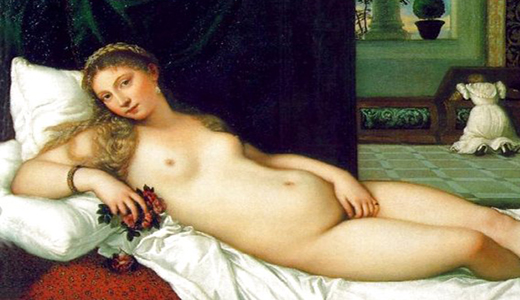 2018
2018
An image from author K.L. Montgomery’s Facebook page.
On Facebook, the algorithms that screen for inappropriate content regularly flag images of women with only their backs or shoulders exposed, while more explicit images of men go uncensored. The selective banning of female nudes has raised questions about what depictions of bodies are deemed sexually explicit, and where the line is drawn between public decency and artistic censorship. Facebook’s regulations state that they “allow photographs of paintings, sculptures, and other art that depicts nude figures,” while they will remove images of genitals, buttocks, and, for women, breasts and nipples. However, the site often bans images as benign as that of Krista Venero, who writes under the pen name K.L. Montgomery, and whose ad for a romance novel showed nothing more than a woman’s exposed back, as the New York Times reported:
The ad showed an image of a woman photographed from behind with a portion of her upper back exposed. It didn’t seem particularly racy, certainly no more than an ad for Olay body wash, showing a woman’s bare back and legs, that Ms. Venero had recently seen. Facebook rejected her ad, however, and when she disputed the decision, a representative told her that it implied nudity and that the company did not allow ads “with a sexual undertone.”
Facebook now says it incorrectly rejected Ms. Venero’s ad, but the back and forth is an example of the social network’s struggles over images of the human body. More precisely, as Facebook processes millions of ads a week through a mix of automation and human review, what is acceptable and what isn’t, and who is making those decisions? Ms. Venero now tends to make her ads “extremely conservative,” she said. “They usually just have a man and woman’s face on them,” she added. “I do have one that has a man’s chest, and I’ve never had any problems with it. But a woman’s shoulder—we have a problem.”
Ms. Venero is not the only one to complain that Facebook is inconsistent when deciding which images are sexually suggestive, particularly pictures of women. The company has flagged a photo of a woman in a T-shirt reading in dim lighting, for example, while allowing a provocative image of a man’s bare stomach for an ad from a Facebook group dedicated to “steamy romance novels” called Beyond 50 Shades. Facebook prohibits adult content in ads, including “depictions of people in explicit or suggestive positions” and “activities that are overly suggestive or sexually provocative.” The rules also extend to “implied nudity,” “excessive visible skin” and images that are too focused on individual body parts “even if not explicitly sexual in nature.” On Facebook’s website, all of the examples showed women.
 1880
1880
Venus of Urbino (detail), by Titian, 1538. Uffizi Gallery.
When Mark Twain first set eyes on Titian’s painting Venus of Urbino, his reaction was a scandalized one. The painting was completed in 1538, commissioned by the Duke of Urbino Guidobaldo II Della Rovere for a private collection. Originally intended as an allegory for marriage, it was a gift and “teaching” model from the Duke to his young wife. Venus didn’t make it into public view until 1736, when it was placed in the Uffizi, where it was at first partially covered for fear of lewdness. Close to 150 years later, Twain’s impression of the Venus, taken from his book A Tramp Abroad, was still one of outrage. Yet his reasoning for why the nude should cause such scorn required deliberate distinctions to be made. Rather than the nudity itself, it was the “attitude” of a single limb which warranted such offense:
At the door of the Uffizi, in Florence, one is confronted by statues of a man and a woman, noseless, battered, black with accumulated grime—they hardly suggest human beings—yet these ridiculous creatures have been thoughtfully and conscientiously fig-leaved by this fastidious generation. You enter, and proceed to that most-visited little gallery that exists in the world—the Tribune—and there, against the wall, without obstructing rag or leaf, you may look your fill upon the foulest, the vilest, the obscenest picture the world possesses—Titian’s Venus. It isn’t that she is naked and stretched out on a bed—no, it is the attitude of one of her arms and hand. If I ventured to describe that attitude, there would be a fine howl—but there the Venus lies, for anybody to gloat over that wants to—and there she has a right to lie, for she is a work of art, and Art has its privileges. I saw young girls stealing furtive glances at her; I saw young men gaze long and absorbedly at her; I saw aged, infirm men hang upon her charms with a pathetic interest. There are pictures of nude women which suggest no impure thought—I am well aware of that. I am not railing at such. What I am trying to emphasize is the fact that Titian’s Venus is very far from being one of that sort. Without any question it was painted for a bagnio and it was probably refused because it was a trifle too strong. In truth, it is too strong for any place but a public Art Gallery.